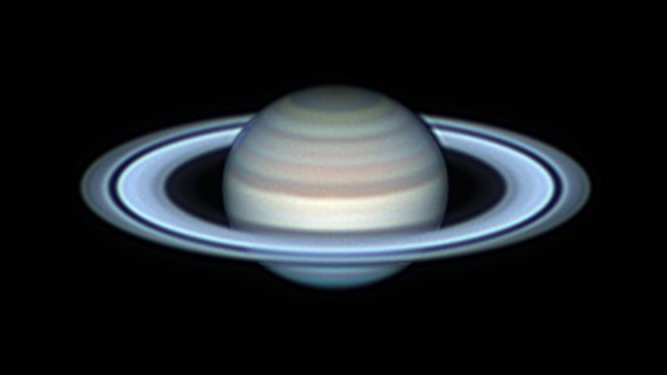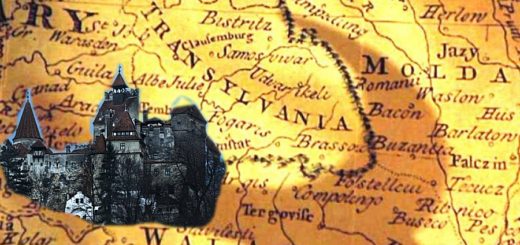Saturn At Opposition August 1-2, Near Jupiter

When viewed through a telescope, Saturn is our solar system’s most glorious planet. But, to the eye, Saturn isn’t as noticeable as bright Jupiter. Luckily, we’re still less than a year past the great conjunction of Saturn and Jupiter. It happened on December 21, 2020. At that time, Saturn and Jupiter were exceedingly close in the sky. Now, as Saturn nears its opposition on August 1-2, 2021, Saturn and Jupiter are still close. Keep reading to learn how Jupiter – and the moon – can help you find Saturn on the sky’s dome.
Earth’s faster motion in orbit brings Saturn to opposition once each year. Opposition is a big yearly milestone for observing the ringed planet Saturn, or any outer planet. It happens when we on Earth fly between that planet and the sun. At opposition, an outer planet is generally closest to Earth and brightest for that year. Saturn’s opposition comes on August 2 at about 06:00 UTC. That is on August 2 at 3 a.m. ADT, 2 a.m. EDT, 1 a.m CDT, 12 midnight MDT … yet on August 1 at 11 p.m. PDT, 10 p.m. Alaskan Time and 8 p.m Hawaiian Time.
And don’t worry about exact times too much. Just know that – in early August 2021 – Saturn is generally opposite the sun in Earth’s sky. At opposition, Saturn rises in the east around sunset, climbs highest up for the night around midnight and sets in the west around sunrise. When opposite the sun, Saturn is visible all night and at its brightest seen from Earth.
How can you find Saturn? First, look for Jupiter, which is the brightest starlike object in the evening sky once Venus sinks below the western horizon after sunset. Saturn is not far from Jupiter, located along the same path the sun travels during the day (the ecliptic). Saturn is the bright golden “star” a short hop to the west of Jupiter. Saturn lies in the direction of the constellation Capricornus and can be found there for the rest of 2021. Does it surprise you that Jupiter will be at opposition on August 19-20? Yes, the heavens are orderly! Plus, in both late July and August, the moon – full or nearly full – can help you find both Saturn and Jupiter. That makes sense, because both Jupiter and Saturn are near opposition, opposite the sun or nearly so. And a full moon is also opposite the sun. Check out the charts below:
Star chart showing moon moving past Jupiter and Saturn in July, 2021.
Saturn (and Jupiter) will be rising in early evening in late July. They’ll be the bright objects near the moon on the nights of July 23 to 26, 2021. Read more.
Star chart showing moon moving past Jupiter and Saturn in August, 2021.
Saturn (and Jupiter) will be rising (or already up) at sunset in late August. They’ll be the bright objects near the moon on the nights of August 19 to 22, 2021. Read more.
Saturn in evening sky rest of 2021
The ringed planet will be in good view in the evening sky for the rest of August and throughout September, October, November and December 2021. Saturn and Jupiter will stay rather close together on the sky’s dome throughout 2021. They’ll remain fixtures of the evening sky for the rest of this year.
In 2021, Saturn comes closest to Earth for the year about 5 hours after it reaches opposition. But it’s nowhere near us in space. In fact, Saturn is the most distant of the worlds we can see with the eye alone. At present, Saturn lies about 10 times the Earth’s distance from the sun, and nine times the Earth-sun distance from Earth. Astronomers refer to one Earth-sun distance as an astronomical unit (AU). Saturn is now about 10 AU from the sun, and nearly 9 AU from us. Heavens-Above gives information about the present distances of the planets from the sun and Earth.
So the distance scale of the solar system is vast, and so is the size scale. For a realistic depiction of Saturn’s size relative to that of Earth (but not its distance), see the illustration below.
Saturn with small Earth next to it, Saturn with rings is 21 Earth diameters across.
Contrasting the size of Saturn and its rings with our planet Earth.
Saturn oppositions come about 2 weeks later each year
Our fast movement in orbit brings Earth between Saturn and the sun every year, or more precisely, about two weeks later every year. For instance, in 2016, Saturn’s opposition was June 3. In 2017, it was June 15. In 2018, opposition came on June 27. In 2019, it was July 9. And in 2020, it was July 20.
If you recognize this golden world tonight or later this month, you’ll also enjoy it throughout the Northern Hemisphere summer, or Southern Hemisphere winter.
If you had a bird’s-eye view of the solar system on the day of Saturn’s opposition, you’d see our planet Earth passing between the sun and Saturn. You’d see the sun, Earth, and Saturn lining up in space. But not for long. Earth moves in orbit at 18 miles (29 km) per second in contrast to about 6 miles (9 km) per second for Saturn. Soon, we’ll be pulling ahead of Saturn in the race of the planets.
Top view of solar system showing sun, Earth, and Saturn lined up with Earth and Saturn on same side of sun: Saturn at opposition.
Not to scale! Saturn is nearly 10 times Earth’s distance from the sun. Heavens-Above can give you Saturn’s present distance from the Earth and sun, or visit If the Moon Were Only 1 Pixel to see planetary distances to scale. Image via NASA.
Superior planets and opposition
The planets that orbit the sun inside Earth’s orbit – Mercury and Venus – can never be at opposition. Only the planets that orbit the sun beyond Earth’s orbit – Mars, Jupiter, Saturn, Uranus, Neptune, and the dwarf planet Pluto – can ever reach opposition, that is, appear opposite the sun in Earth’s sky.
All the planets farther from the sun reach opposition every time our swifter-moving planet sweeps between the sun and these superior planets, the planets that orbit the sun outside Earth’s orbit. Mars returns to opposition every other year. Jupiter’s opposition happens about one month later each year, whereas Saturn’s opposition occurs about two weeks later yearly. The farther that a planet resides from the sun, the shorter the period of time between successive oppositions.
Telescopic image of Jupiter on the left, and telescopic image of Saturn on the right.
View at EarthSky Community Photos. | Patrick Prokop created this composite image of Jupiter and Saturn. He wrote: “I took these images between 2 and 3 a.m. on the morning of July 15, 2021 … These 2 will dominate the summer nighttime sky this year.” Thank you, Patrick!
Saturn is a world of rings and moons
Saturn is the sixth planet outward from the sun. People in ancient times saw it as a golden “star” that moved among the fixed stars: a wanderer. It wasn’t until astronomers began using telescopes in the 17th century that they saw its rings. In the 1950s, astronomers spoke of Saturn as having three rings. But spacecraft in the latter part of the 20th century showed vastly more detail. They revealed that Saturn actually has thousands of thin, finely detailed rings made of tiny chunks of ice. Saturn also has at least 62 moons with confirmed orbits. Only 53 of Saturn’s moons have names, and only 13 have diameters larger than 50 kilometers (about 30 miles).
Saturn is truly a wondrous world of rings and moons. It’s everyone’s favorite celestial object to gaze at through a small telescope, so if there’s a public astronomy night near you this month – go!
Solid black circle against pale crescent with vertical black line – edge view of rings.
The Cassini spacecraft, which orbited Saturn from 2004 to 2017, obtained almost unbelievably stunning images of the planet. Here, a moon, Rhea, occults – or passes in front of – a crescent Saturn. Image via Cassini Imaging Team/ SSI/ ESA/ NASA-JPL. See more images of Saturn from Cassini.
Bottom line: Look for Saturn at and around opposition in early August 2021. It will be shining in the southeast at nightfall. Clouded out tonight? No problem. Saturn will be in an excellent place to observe throughout late July, August, September and October 2021.
Enjoying EarthSky so far? Sign up for our free daily newsletter today!



 Creators of mankind
Creators of mankind Description of “Tall white aliens”
Description of “Tall white aliens” Where they came from?
Where they came from? About hostile civilizations
About hostile civilizations The war for the Earth
The war for the Earth “Tall white aliens” about eternal life
“Tall white aliens” about eternal life Video: “Nordic aliens”
Video: “Nordic aliens” Aliens
Aliens Alien encounters
Alien encounters The aliens base
The aliens base UFO
UFO Technology UFO
Technology UFO Underground civilization
Underground civilization Ancient alien artifacts
Ancient alien artifacts Military and UFO
Military and UFO Mysteries and hypotheses
Mysteries and hypotheses Scientific facts
Scientific facts


















